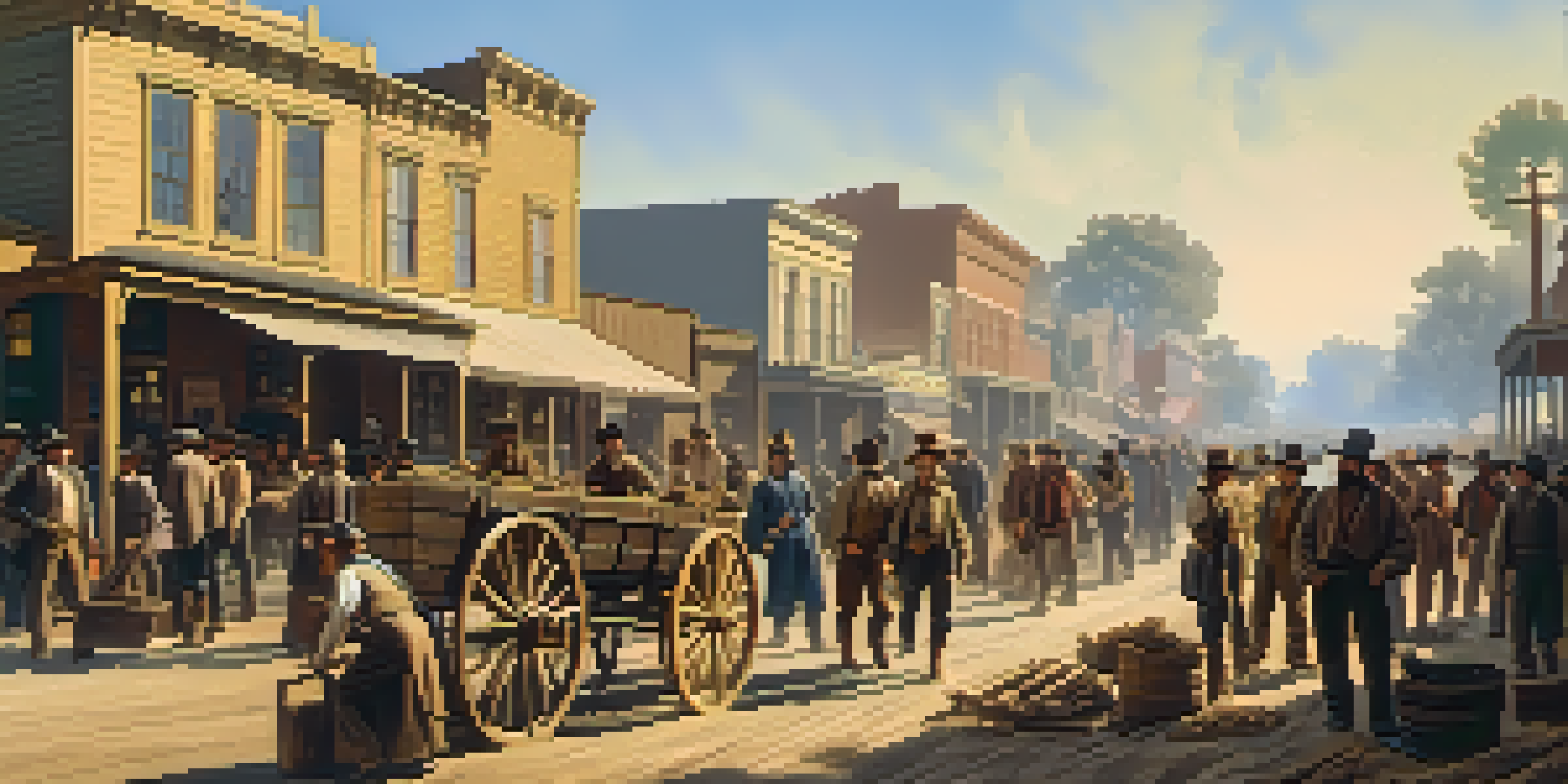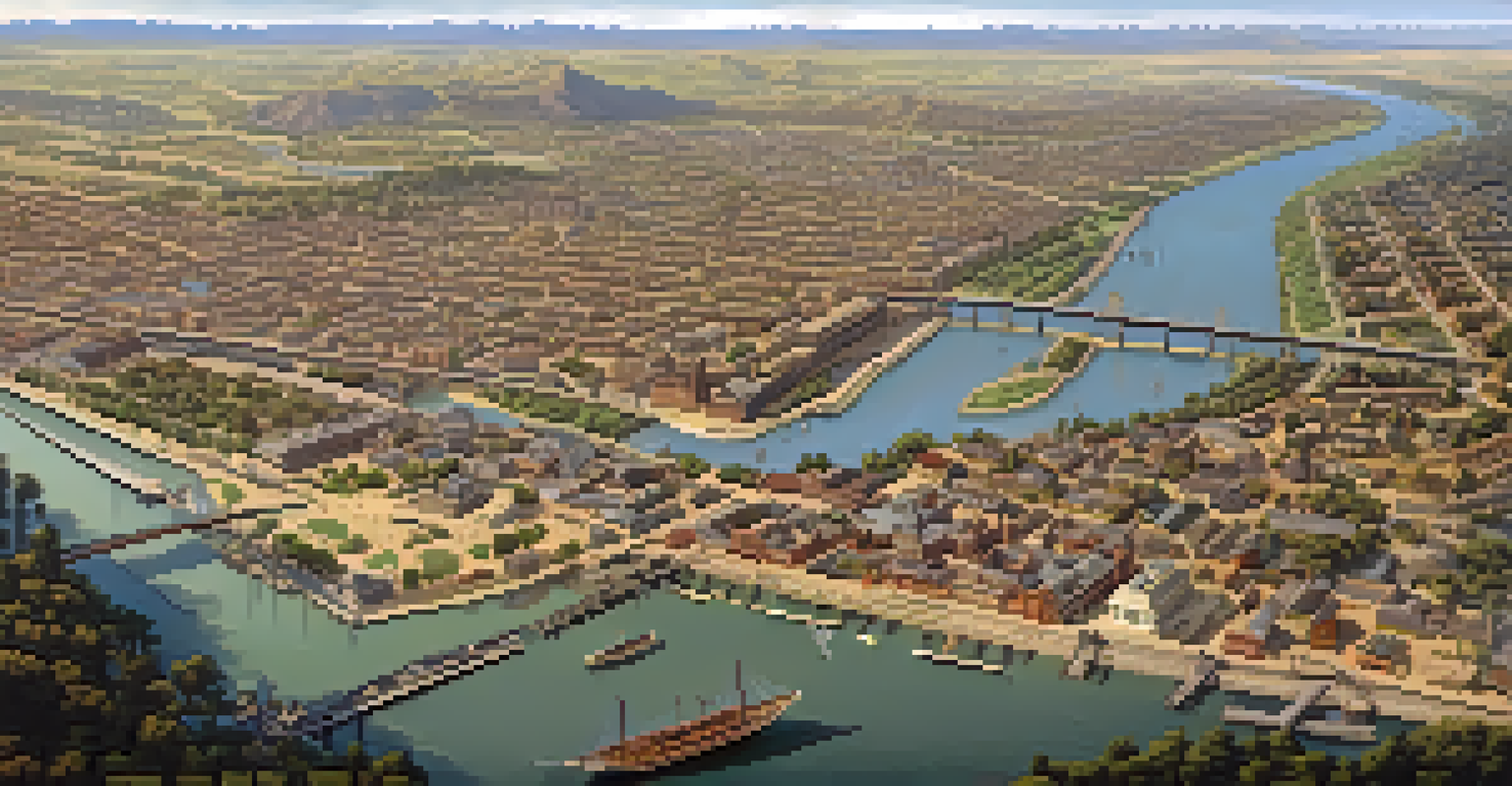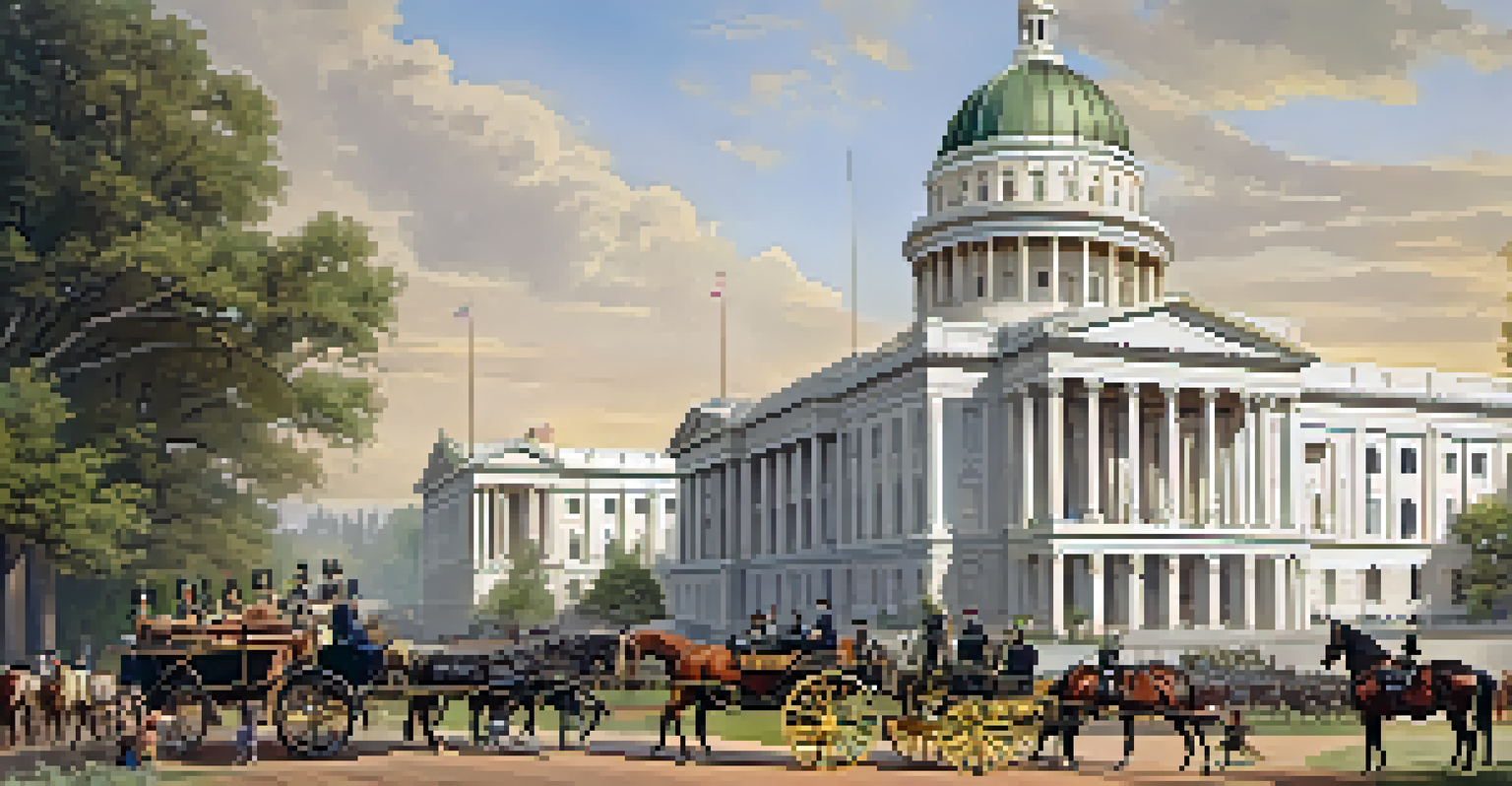The Gold Rush Era: Sacramento's Impact on California History

The Start of the Gold Rush and Sacramento's Founding
The Gold Rush era began in 1848, driven by the discovery of gold at Sutter's Mill, not far from Sacramento. This monumental event transformed the region almost overnight, attracting thousands of hopeful prospectors and entrepreneurs. Sacramento, originally a modest settlement, rapidly evolved into a bustling hub for gold seekers, becoming a vital city in California's burgeoning history.
The Gold Rush was a powerful magnet that drew people from all walks of life, fostering a community that thrived on diversity and opportunity.
As miners flocked to the area, they needed supplies, services, and shelter, leading to a boom in Sacramento's economy. The influx of people created a vibrant marketplace filled with everything from food to mining tools. This growth set the stage for Sacramento to become a crucial player in California’s development during the Gold Rush.
The establishment of Sacramento as a key transit point for gold shipments solidified its importance. Ships and wagons moved gold and goods in and out of the city, creating a network that connected miners to the rest of the country. This early infrastructure laid the groundwork for Sacramento's future as a significant urban center.
Economic Transformation: Sacramento as a Trade Hub
Sacramento's strategic location near the Sacramento River made it an ideal trade hub during the Gold Rush. The river provided a vital transportation route for goods, connecting the city to both mining camps and markets. As a result, Sacramento saw an explosion of businesses catering to the needs of miners and settlers, significantly boosting the local economy.

With the growing population, various industries flourished, including agriculture, retail, and manufacturing. The demand for food and supplies led to the establishment of farms and businesses in the surrounding areas, further enriching the local economy. This diversification of industries ensured that Sacramento was not solely reliant on gold mining, promoting long-term stability.
Gold Rush Transformed Sacramento
The discovery of gold in 1848 rapidly evolved Sacramento from a modest settlement into a bustling economic hub.
Moreover, the economic boom attracted investors and entrepreneurs from across the nation, leading to further development. This influx of capital enabled the construction of infrastructure, such as railroads and roads, which connected Sacramento more effectively to the rest of California. These developments transformed the city into a key player in the state's economic landscape.
Cultural Melting Pot: Diversity in Sacramento
The Gold Rush era brought a wave of diverse cultures to Sacramento, as prospectors came from around the world, including China, Europe, and Latin America. This mix of cultures created a unique social fabric, significantly influencing the city’s identity. As different communities settled in Sacramento, they brought their traditions, languages, and cuisines, enriching the local culture.
Sacramento transformed from a small settlement to the heart of California's political and economic landscape during the Gold Rush, symbolizing the spirit of resilience and growth.
Local festivals and events began to reflect this diversity, celebrating various customs and traditions. The blending of cultures led to a vibrant arts scene, with music, dance, and culinary experiences that showcased the city’s multicultural roots. Such cultural exchanges fostered a sense of community among the diverse populations, making Sacramento a lively place to live.
However, the influx of immigrants also led to tensions and challenges, as competition for resources sometimes sparked conflict. Discrimination against certain groups, particularly the Chinese miners, highlighted the complexities of this cultural melting pot. Nevertheless, Sacramento’s diverse population ultimately contributed to its resilience and growth during this transformative period.
Infrastructure Development: Building a Modern City
As Sacramento's population swelled during the Gold Rush, the need for infrastructure became paramount. The city witnessed rapid development of roads, bridges, and public buildings to accommodate the growing community. These improvements were essential for supporting commerce and enhancing the overall quality of life in the city.
Key projects, such as the construction of levees to prevent flooding from the Sacramento River, showcased the city’s commitment to addressing environmental challenges. This infrastructure not only protected the community but also facilitated trade and transportation, ensuring that Sacramento remained a vital economic center. Improvements to the water and sanitation systems further contributed to public health and safety.
Diverse Cultures Shaped Identity
The influx of prospectors from around the world during the Gold Rush created a unique cultural melting pot in Sacramento.
By the end of the Gold Rush, Sacramento had transformed from a small settlement into a modern city, equipped with the infrastructure needed to support a thriving population. These developments positioned Sacramento for continued growth and prosperity in the years to come, paving the way for its future successes as California's capital.
Political Changes: Sacramento Becomes the State Capital
In 1850, California became a state, and Sacramento's rapid growth and strategic location made it a prime candidate for the state capital. The decision to designate Sacramento as the capital in 1854 marked a significant political shift that would shape the city’s future. This new status not only elevated Sacramento's importance in California but also attracted government officials and associated businesses.
The establishment of government institutions and infrastructure further solidified Sacramento’s role as the political heart of California. Buildings such as the State Capitol were constructed, symbolizing the city’s new prominence. This political transformation brought both opportunities and challenges, as the city had to adapt to its newfound responsibilities.
Becoming the state capital also meant that Sacramento was at the forefront of political discourse and decision-making in California. The city became a hub for political activity, influencing legislation and state policies. This shift enriched Sacramento's historical narrative, entwining its growth with the broader story of California's development.
Environmental Impact: Gold Rush and Its Consequences
The Gold Rush era, while a time of economic prosperity, also had profound environmental consequences. The rush for gold led to extensive mining operations, which often resulted in significant ecological damage. Rivers were diverted, landscapes were altered, and pollution became rampant as miners sought their fortunes in the hills around Sacramento.
The practice of hydraulic mining, in particular, caused severe erosion and sedimentation in waterways, affecting fish populations and local ecosystems. As the environmental toll became apparent, communities began to recognize the need for sustainable practices and conservation efforts. This awareness would eventually influence policies aimed at protecting California's natural resources.
Infrastructure Built for Growth
As Sacramento's population grew, significant infrastructure developments were essential for supporting commerce and enhancing quality of life.
The legacy of the Gold Rush serves as a reminder of the balance between economic growth and environmental stewardship. While Sacramento thrived during this period, the lessons learned about environmental impact continue to resonate today, shaping modern conversations around sustainability and resource management in California.
Legacy of the Gold Rush: Sacramento's Lasting Influence
The Gold Rush era left an indelible mark on Sacramento, shaping its identity and trajectory in profound ways. The city emerged as a symbol of opportunity, resilience, and cultural diversity, attracting generations of newcomers seeking a better life. This legacy continues to influence Sacramento’s character, fostering a community that celebrates its rich history.
Today, Sacramento honors its Gold Rush heritage through museums, festivals, and historical sites that educate residents and visitors alike. These efforts ensure that the stories of those who contributed to the city’s growth are preserved and celebrated. The blend of history and modernity makes Sacramento a unique destination in California.

Furthermore, the Gold Rush era set the stage for California's development as a leading state in the nation. The economic, cultural, and political foundations laid during this time continue to resonate, influencing the state’s identity and role in the broader American narrative. Sacramento stands as a testament to the transformative power of the Gold Rush, a pivotal chapter in California's history.